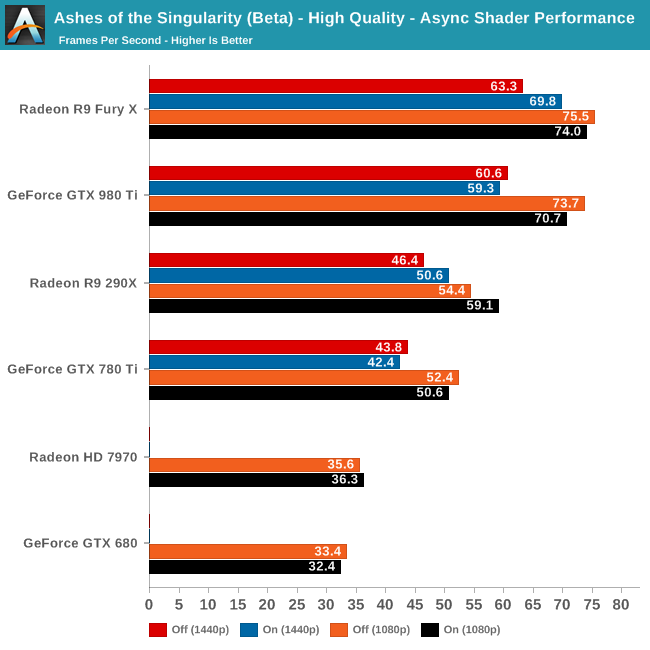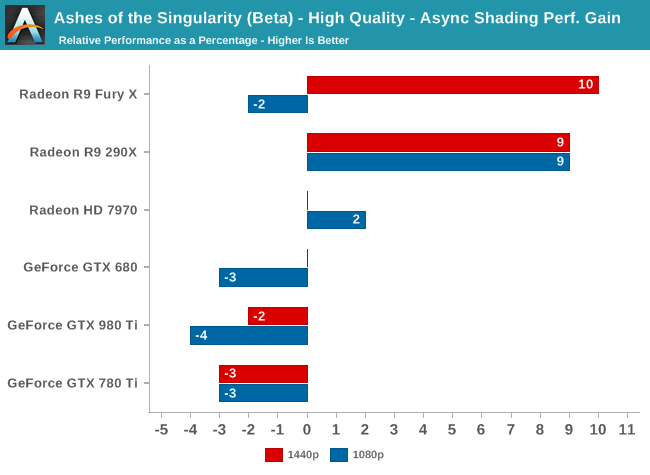Ashes of the Singularity Revisited: A Beta Look at DirectX 12 & Asynchronous Shading
by Daniel Williams & Ryan Smith on February 24, 2016 1:00 PM ESTThe Performance Impact of Asynchronous Shading
Finally, let’s take a look at Ashes’ latest addition to its stable of DX12 headlining features; asynchronous shading/compute. While earlier betas of the game implemented a very limited form of async shading, this latest beta contains a newer, more complex implementation of the technology, inspired in part by Oxide’s experiences with multi-GPU. As a result, async shading will potentially have a greater impact on performance than in earlier betas.
Update 02/24: NVIDIA sent a note over this afternoon letting us know that asynchornous shading is not enabled in their current drivers, hence the performance we are seeing here. Unfortunately they are not providing an ETA for when this feature will be enabled.

Since async shading is turned on by default in Ashes, what we’re essentially doing here is measuring the penalty for turning it off. Not unlike the DirectX 12 vs. DirectX 11 situation – and possibly even contributing to it – what we find depends heavily on the GPU vendor.

All NVIDIA cards suffer a minor regression in performance with async shading turned on. At a maximum of -4% it’s really not enough to justify disabling async shading, but at the same time it means that async shading is not providing NVIDIA with any benefit. With RTG cards on the other hand it’s almost always beneficial, with the benefit increasing with the overall performance of the card. In the case of the Fury X this means a 10% gain at 1440p, and though not plotted here, a similar gain at 4K.
These findings do go hand-in-hand with some of the basic performance goals of async shading, primarily that async shading can improve GPU utilization. At 4096 stream processors the Fury X has the most ALUs out of any card on these charts, and given its performance in other games, the numbers we see here lend credit to the theory that RTG isn’t always able to reach full utilization of those ALUs, particularly on Ashes. In which case async shading could be a big benefit going forward.
As for the NVIDIA cards, that’s a harder read. Is it that NVIDIA already has good ALU utilization? Or is it that their architectures can’t do enough with asynchronous execution to offset the scheduling penalty for using it? Either way, when it comes to Ashes NVIDIA isn’t gaining anything from async shading at this time.

Meanwhile pushing our fastest GPUs to their limit at Extreme quality only widens the gap. At 4K the Fury X picks up nearly 20% from async shading – though a much smaller 6% at 1440p – while the GTX 980 Ti continues to lose a couple of percent from enabling it. This outcome is somewhat surprising since at 4K we’d already expect the Fury X to be rather taxed, but clearly there’s quite a bit of shader headroom left unused.










153 Comments
View All Comments
TheJian - Sunday, March 6, 2016 - link
The highlight here isn't dx12, but rather how badly AMD is doing DX11, which is what most games will run on for quite some time to come (only 10% run win10, and much of that base doesn't have a card that can run this game at even 1080P at 30fps). A decent sized group of win10 users go back to win7 also...LOL. I'm more interested in Vulkan, now that it's out, I think it will take over dx12 after a year as it runs everywhere but consoles and they are a totally different animal anyway.This just goes to show what happens when you can't afford to support your products. IE, AMD constantly losing money quarter after quarter while R&D drops too. NV on the other hand, has the cash to massively improve dx11 (which is 90% of the market, more if you consider not everyone running win10 is even a gamer), while also making a dx12 driver. AMD clearly needs to devote more money to their current card users (dx11), but can't afford to. AMD is spending their money on the wrong things time and time again. You can blame consoles for this last 5yrs of losses, as that money should have went into making ZEN 4yrs ago, much faster DX11 support, mobile chips should be on rev 5-6 etc like NV and everyone else etc etc. We would not be looking at NV owning 82%+ of the gpu market right now, and Intel would have had a major competition problem for the last 4-5 yrs instead of basically being able to pour all their resources into mobile while beating AMD to death on cpu.
EugenM - Tuesday, June 7, 2016 - link
I cannot speak of AMD CPUs, but AMD gpus are doing very well on DX11 games, its not the DX11 implementation of AMD that is at fault for performance issues, rather than Nvidia sabotaging time and time again their games, every game which is labeled Nvidia has a potential to sabotage the entire AMD lineup and AMD has little to nothing to do about it, this is not a tin foil conspirancy theory, its a fact proven game after game after game and easelly found on google, try searching for batman games and other epic unreal engine games, try searching for crysis 2 and nvidia gameworks games, youll see what i mean. If youre a small company you cannot really do much about a big monopoly like Nvidia and Intel youre 1 fighting vs 2. Dirty tactics against AMD and even illegal tactics have also been applied by Intel vs AMD, thats why Intel was fined with a huge ammount of money but in the end the damage to AMD was already done and it was too late for AMD to recover properly. You need to realise not everything is so simple.jacksonjacksona - Thursday, March 17, 2016 - link
( www).(ajkobeshoes).(com )christian louboutin
jordan shoes $60-
handbag
AF tank woman
puma slipper woman
=====
( www).(ajkobeshoes).(com )
hhhhhhhh
hhhhhhhh